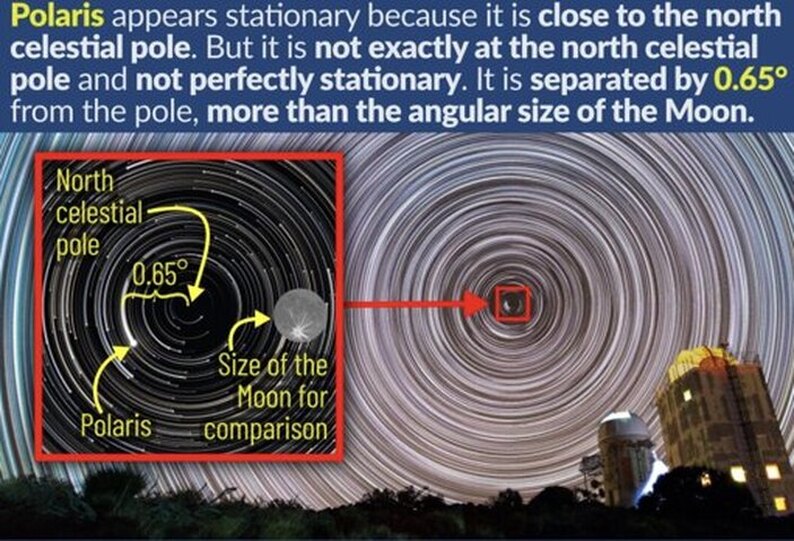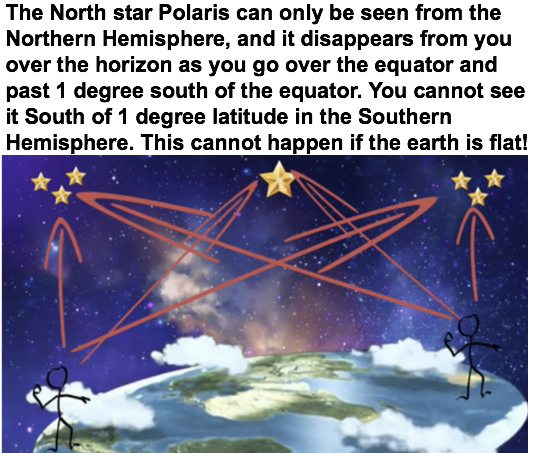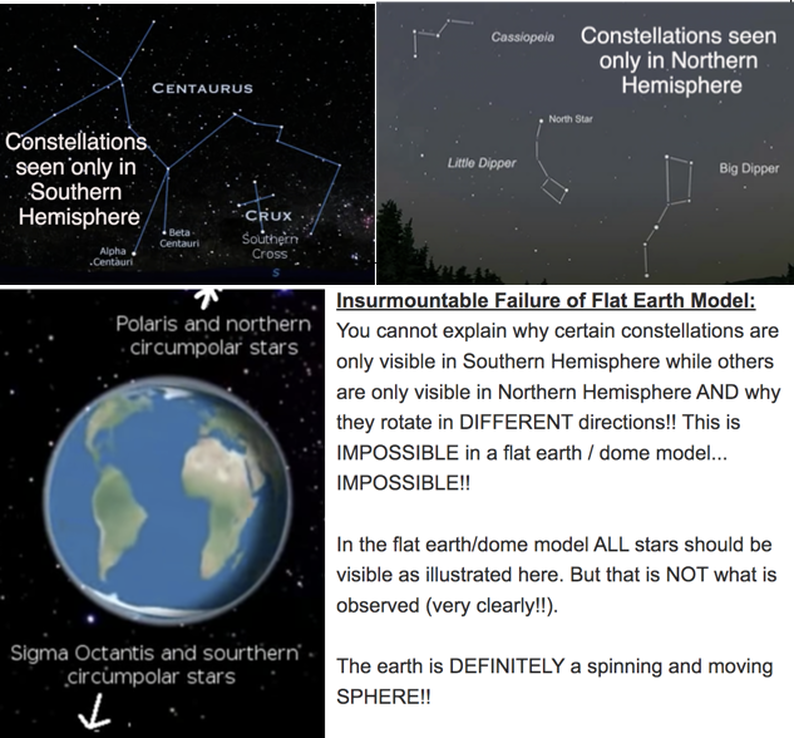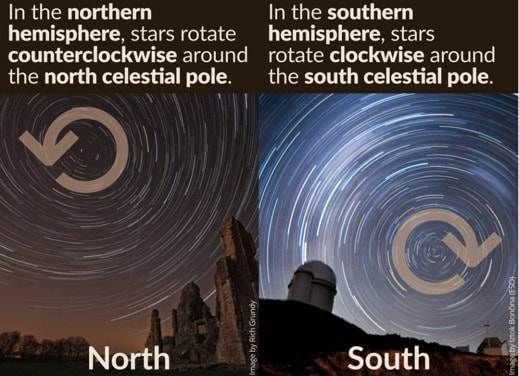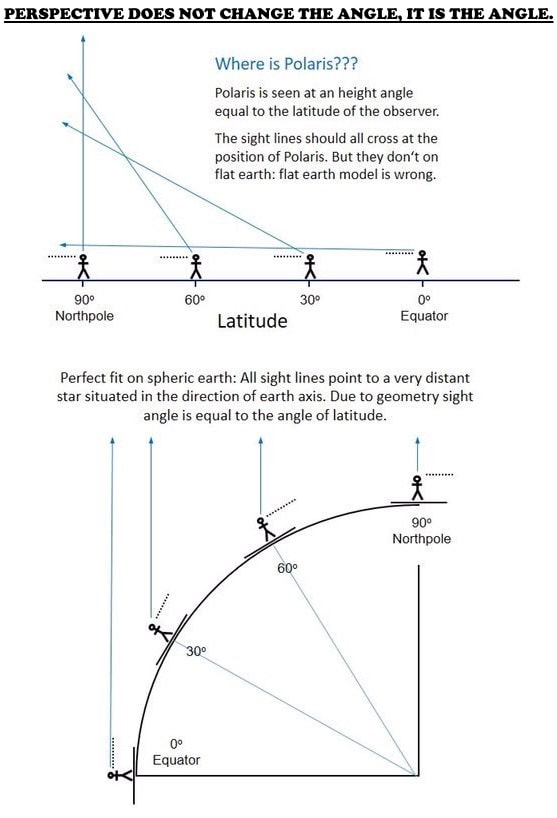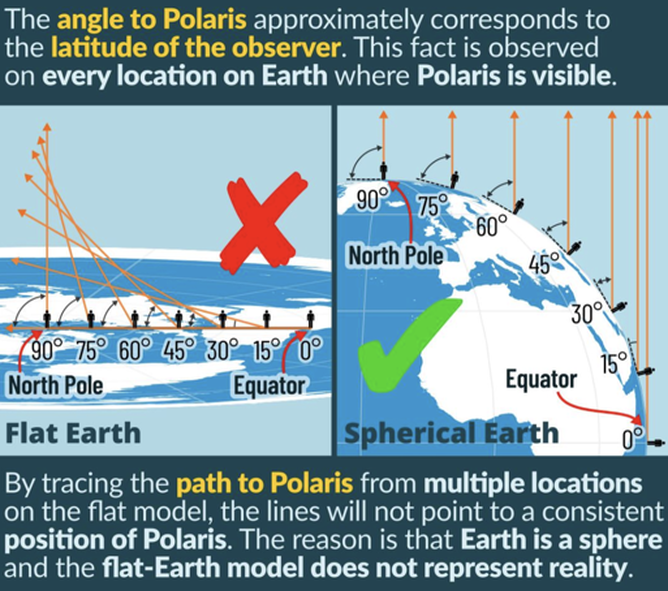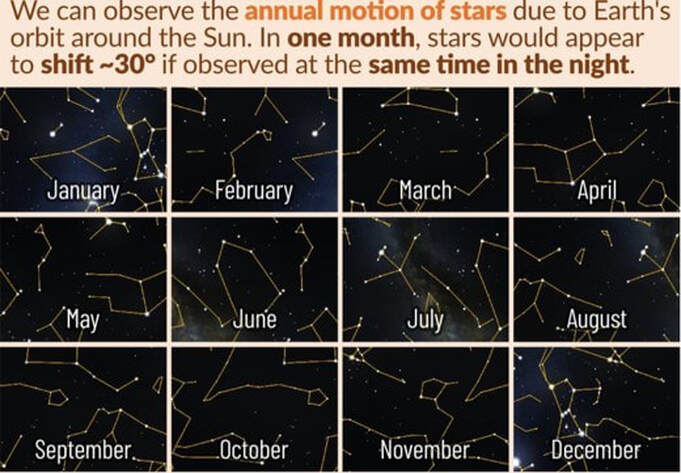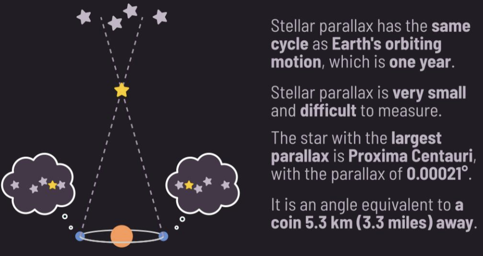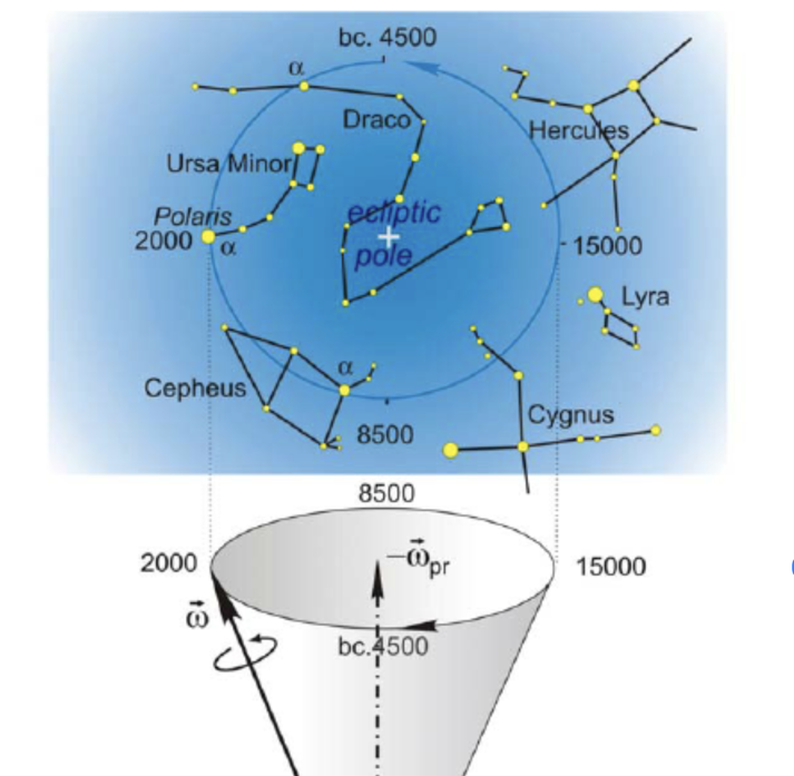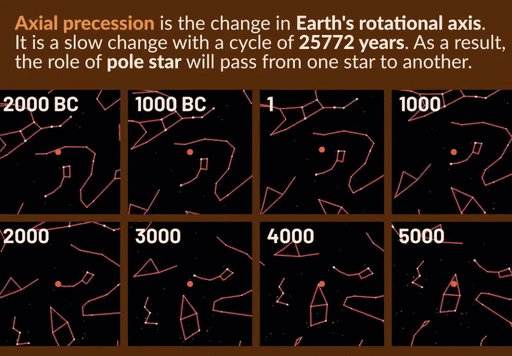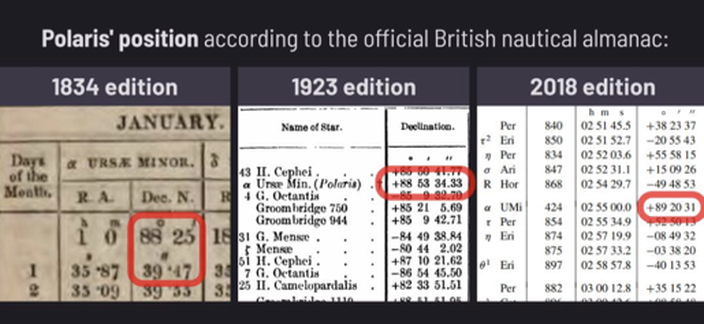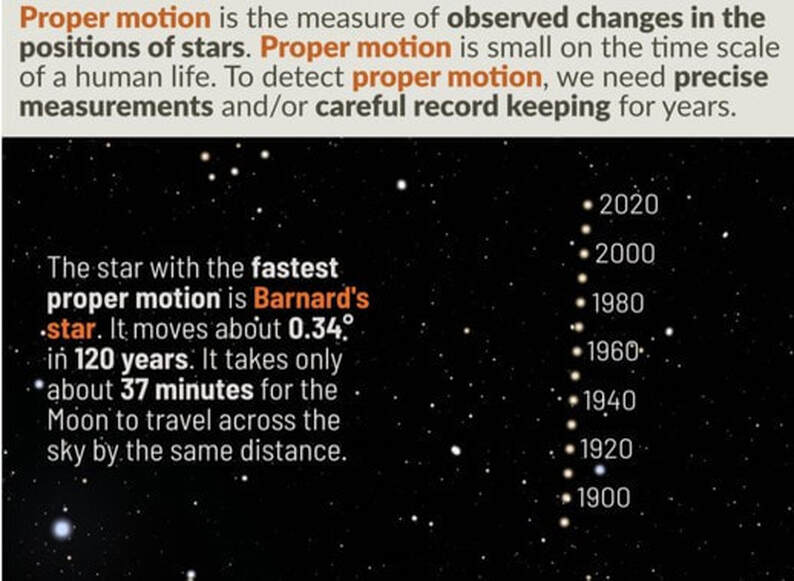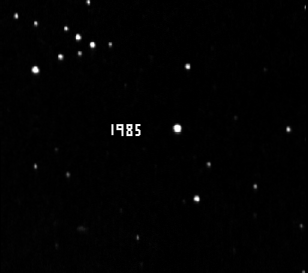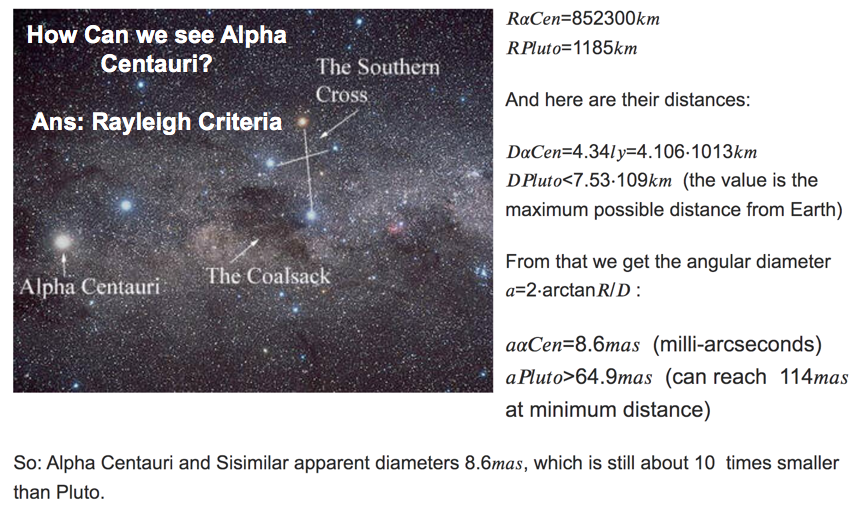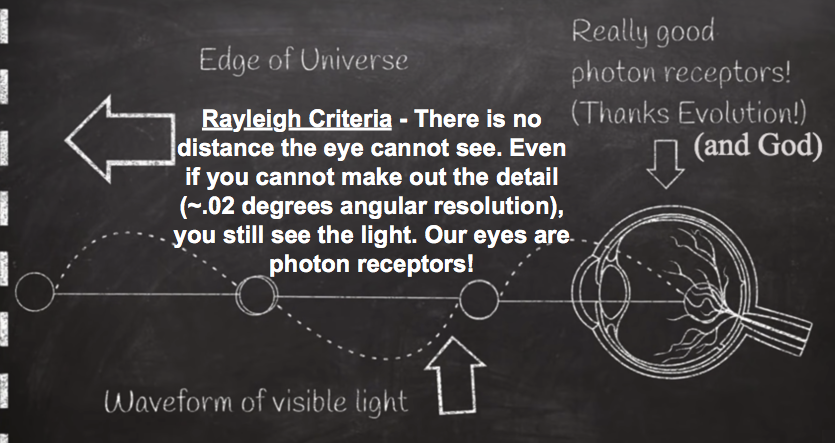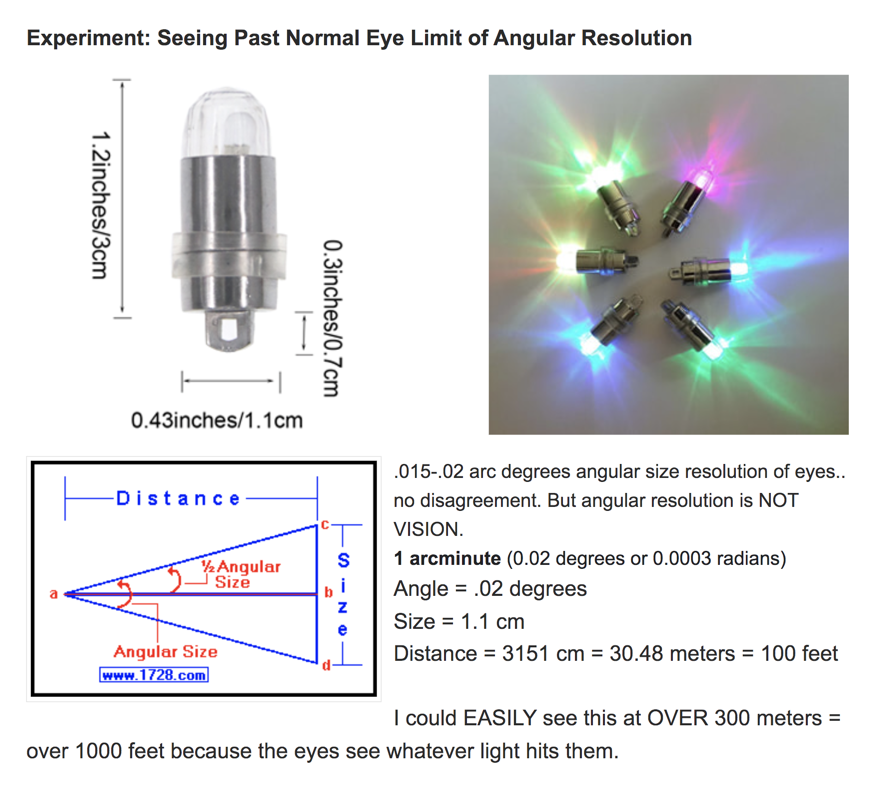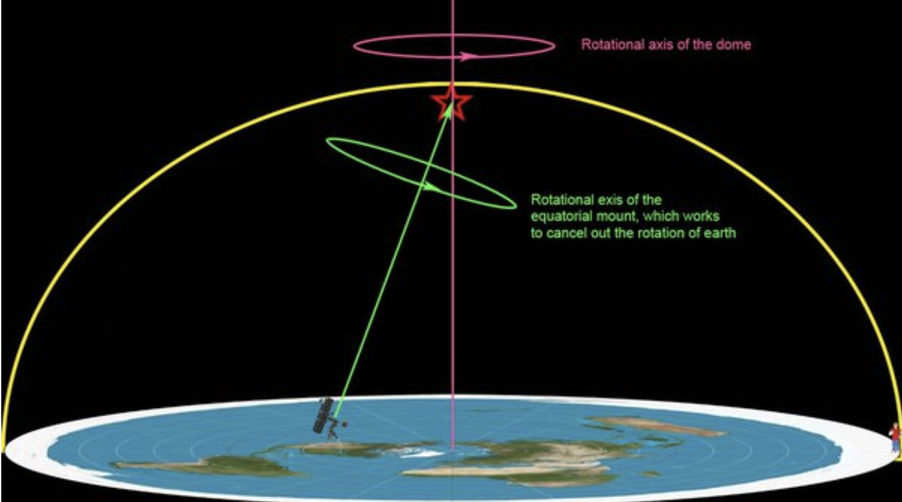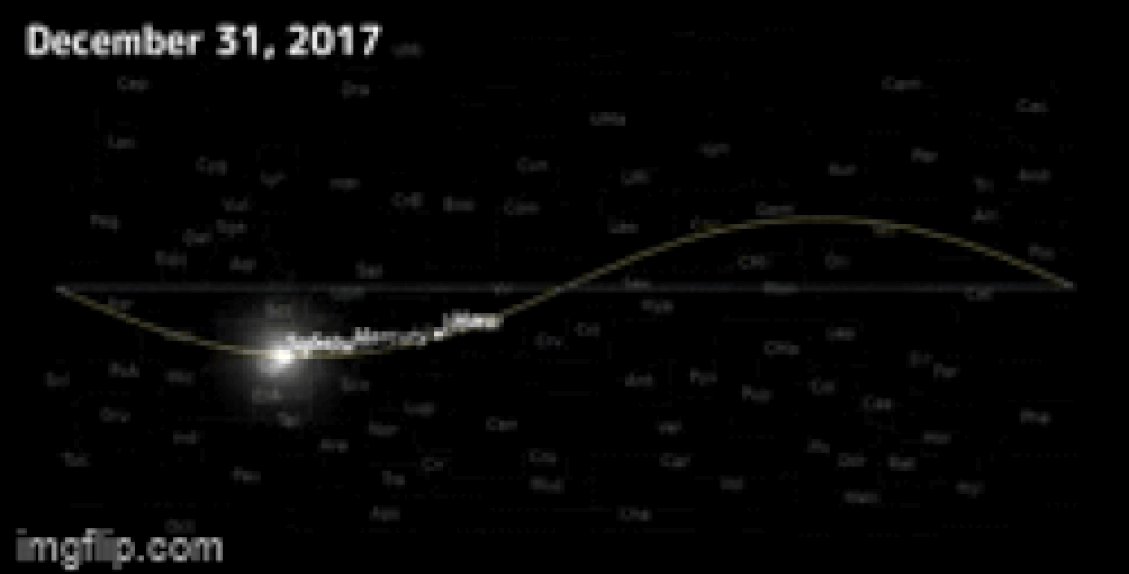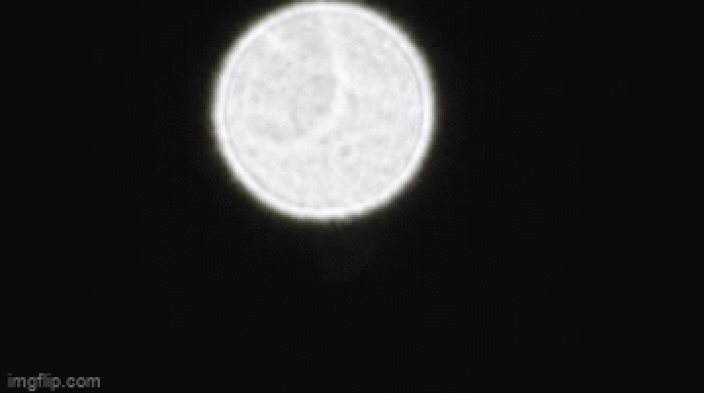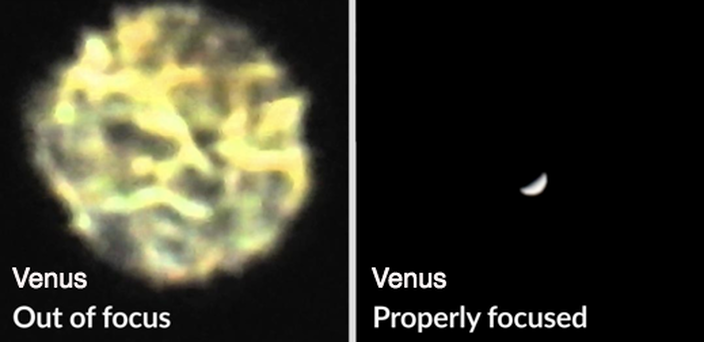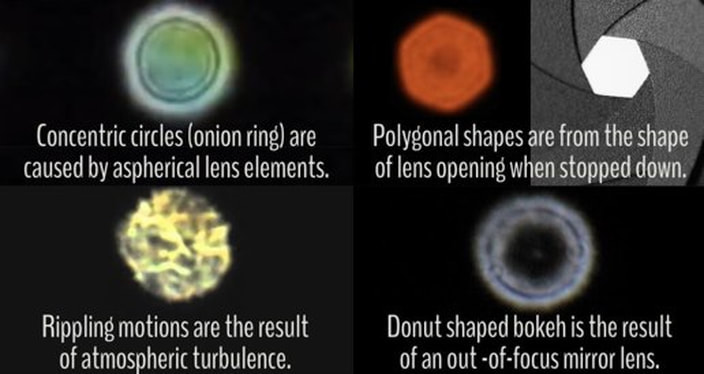Stars
Diurnal Motion – Possibly the First Evidence of Spherical Earth
Explains parallax exactly (negative parallax are just statistical uncertainties.
Explains precession and stars slowly changing 26,000 year cycle
Explains why the 12 zodiac constellations appear when they do each time of year at the equator
Nautical Almanac
Polaris only seen North of equator
Polaris Altitude and Angle
Steller aberration
Doppler Effect
Proper Motion of Stars
Stars Annual Motion
Planets
Why are all planets Spheres?
Explains Epicycles
Planetary elliptical orbits predict ours
Venus and Mercury Orbits in ecliptic proves earths motion around sun
Explains Ecliptic of planets
Perihelion of mercury
Neptune
Moons Orbiting Jupiter
Alpha Centauri and rotating and moving stars. Two different polestars and two different sets of counterrotating stars above firmament.
Misconception: The position of stars never change.
There are tons of movement the stars do relative to Earth. They all orbit the point above the North Pole, even Polaris, even though it’s very close to it. There’s also stellar parallax that can be measured between summer and winter. There are other stars that change position relatively quickly, within human lifetimes (such as Barnard’s star).
1) Polaris Moving
2) Daily Star Trails
3) Annual Changes
4) Slow Relative Motion
5) Seeing The Large Distances 5000-6000 visible stars.
Stars, planets and bokeh... Lied to we see stars at impossible distances.
Angular size doesn't matter. Luminosity and brightness do
Daily, Annual and Relative Motions... precession and back and forth rocking.
==> All the stars we see in the night sky are relatively close to us in the Galactic sense and traveling around the center of the galaxy with us and you are not going to see much movement.
Diurnal Motion – Possibly the First Evidence of Spherical Earth
Explains parallax exactly (negative parallax are just statistical uncertainties.
Explains precession and stars slowly changing 26,000 year cycle
Explains why the 12 zodiac constellations appear when they do each time of year at the equator
Nautical Almanac
Polaris only seen North of equator
Polaris Altitude and Angle
Steller aberration
Doppler Effect
Proper Motion of Stars
Stars Annual Motion
Planets
Why are all planets Spheres?
Explains Epicycles
Planetary elliptical orbits predict ours
Venus and Mercury Orbits in ecliptic proves earths motion around sun
Explains Ecliptic of planets
Perihelion of mercury
Neptune
Moons Orbiting Jupiter
Alpha Centauri and rotating and moving stars. Two different polestars and two different sets of counterrotating stars above firmament.
Misconception: The position of stars never change.
There are tons of movement the stars do relative to Earth. They all orbit the point above the North Pole, even Polaris, even though it’s very close to it. There’s also stellar parallax that can be measured between summer and winter. There are other stars that change position relatively quickly, within human lifetimes (such as Barnard’s star).
1) Polaris Moving
2) Daily Star Trails
3) Annual Changes
4) Slow Relative Motion
5) Seeing The Large Distances 5000-6000 visible stars.
Stars, planets and bokeh... Lied to we see stars at impossible distances.
Angular size doesn't matter. Luminosity and brightness do
Daily, Annual and Relative Motions... precession and back and forth rocking.
==> All the stars we see in the night sky are relatively close to us in the Galactic sense and traveling around the center of the galaxy with us and you are not going to see much movement.
Alpha Centauri and rotating and moving stars. Two different polestars and two different sets of counterrotating stars above firmament.
Misconception: The position of stars never change.
There are tons of movement the stars do relative to Earth. They all orbit the point above the North Pole, even Polaris, even though it’s very close to it. There’s also stellar parallax that can be measured between summer and winter. There are other stars that change position relatively quickly, within human lifetimes (such as Barnard’s star).
1) Polaris Moving
2) Daily Star Trails
3) Annual Changes
4) Slow Relative Motion
5) Seeing The Large Distances 5000-6000 visible stars.
Stars, planets and bokeh... Lied to we see stars at impossible distances.
Angular size doesn't matter. Luminosity and brightness do
Daily, Annual and Relative Motions... precession and back and forth rocking.
==> All the stars we see in the night sky are relatively close to us in the Galactic sense and traveling around the center of the galaxy with us and you are not going to see much movement.
Misconception: The position of stars never change.
There are tons of movement the stars do relative to Earth. They all orbit the point above the North Pole, even Polaris, even though it’s very close to it. There’s also stellar parallax that can be measured between summer and winter. There are other stars that change position relatively quickly, within human lifetimes (such as Barnard’s star).
1) Polaris Moving
2) Daily Star Trails
3) Annual Changes
4) Slow Relative Motion
5) Seeing The Large Distances 5000-6000 visible stars.
Stars, planets and bokeh... Lied to we see stars at impossible distances.
Angular size doesn't matter. Luminosity and brightness do
Daily, Annual and Relative Motions... precession and back and forth rocking.
==> All the stars we see in the night sky are relatively close to us in the Galactic sense and traveling around the center of the galaxy with us and you are not going to see much movement.
**The Stars are MOVING!**
The stars are MOVING and so are we!
Many flat-Earthers think that Polaris is stationary and that it is a ‘special star’ because other stars are in motion around it. They would take that as ‘evidence’ that the Earth is motionless. They are wrong. Polaris is merely a regular star, just like the others AND it is moving slowly due to the earth's precession and currently is not even the exact North Pole (off by .65 degrees). Stationary Flat earth debunked.
Besides Polaris slow moving, there are other motions of stars daily as evidenced by Star Trails (flat earthers acknowledge but can't explain why the star trails are rotating in opposite directions in Northern and Southern Hemisphere). And just for clarity, a star trail is a type of photograph that uses long exposure times to capture diurnal circles, the apparent motion of stars in the night sky due to Earth's rotation. Stationary Flat earth debunked again.
Next there is the annual motion of stars due to earth's yearly orbit around the sun. On each day, we can observe stars to drift about 1° in their motion around the celestial pole. In a month, they will appear to have moved about 30° when observed at the same time in the night. In a year, they will be back to their original positions as the same day in the previous year. The observation of annual motion is the basis of the solar calendar system we are using today. Stationary Flat earth debunked yet again.
Proper Motion = apparent motion of stars. This is slow, but the stars ARE moving relative to us even factoring in daily and annual motions. This is due to the stars ACTUALLY moving relative to us and us moving relative to them. While this motion is very small it is detectable in stars that are close. Barnards star is the fastest apparent motion , but it is moving so slow, that it moves only .34 degrees, but it is measurable. Yet once again debunking a Stationary Flat Earth!
The stars are MOVING and so are we!
Many flat-Earthers think that Polaris is stationary and that it is a ‘special star’ because other stars are in motion around it. They would take that as ‘evidence’ that the Earth is motionless. They are wrong. Polaris is merely a regular star, just like the others AND it is moving slowly due to the earth's precession and currently is not even the exact North Pole (off by .65 degrees). Stationary Flat earth debunked.
Besides Polaris slow moving, there are other motions of stars daily as evidenced by Star Trails (flat earthers acknowledge but can't explain why the star trails are rotating in opposite directions in Northern and Southern Hemisphere). And just for clarity, a star trail is a type of photograph that uses long exposure times to capture diurnal circles, the apparent motion of stars in the night sky due to Earth's rotation. Stationary Flat earth debunked again.
Next there is the annual motion of stars due to earth's yearly orbit around the sun. On each day, we can observe stars to drift about 1° in their motion around the celestial pole. In a month, they will appear to have moved about 30° when observed at the same time in the night. In a year, they will be back to their original positions as the same day in the previous year. The observation of annual motion is the basis of the solar calendar system we are using today. Stationary Flat earth debunked yet again.
Proper Motion = apparent motion of stars. This is slow, but the stars ARE moving relative to us even factoring in daily and annual motions. This is due to the stars ACTUALLY moving relative to us and us moving relative to them. While this motion is very small it is detectable in stars that are close. Barnards star is the fastest apparent motion , but it is moving so slow, that it moves only .34 degrees, but it is measurable. Yet once again debunking a Stationary Flat Earth!
**Why Polaris Alone Debunks the Flat Earth in Three Ways**
1) The North star Polaris can only be seen from the Northern Hemisphere, and it disappears from you over the horizon as you go over the equator and past 1 degree south of the equator. You cannot see it South of 1 degree latitude in the Southern Hemisphere**. You just can't... No way. Flat earth debunked.
2) But it gets even worse for flat earthers. At the North pole the North Star (Polaris) is Directly overhead, and for every degree in latitude you move towards the equator, the degree between Polaris and the horizon reduces EXACTLY MATCHING POSITION ON A GLOBE!
This is ALSO IMPOSSIBLE on a flat and stationary earth.
Flat earth debunked again from just Polaris.
3) No amount of perspective and refraction can bail flat earthers out because embarrassingly on their map, Australia and South America are on opposite sides of the disk, so how could they look directly up and see the same set of stars on opposite sides of the flat earth and NOT SEE POLARIS (see image here - Polaris is the star in the middle)? Impossible! Polaris debunks flat earth yet again.
**Note: Currently Polaris is at a declination of a bit over 89 degrees, which means that no one south of 1 degree south latitude can see Polaris, but it CAN be visible just a little South of the equator for this reason.
There is just no way on a stationary flat earth that you can have stars rotate clockwise in the Northern Hemisphere and Counterclockwise in the Souther Hemisphere rotate clockwise. Because the earth rotates the sky does appear to rotate.
---
Stellar Parallax:
Note: Flat earthers love to point out Polaris is closer than we thought. How could we be off
It's hard to measure tiny angles to get the -- we've actually got better at it!
#1 is it not directly over anything -- it's 40 arc minutes off center (2/3 degree)
#2 it has moved -- measurably since 1980's (mostly due to precession), it was further from center!
#3 it's moving in the same general direction as we are, our relative speeds are not great
#4 it's very far away which means the angular shifts from our relative motions are very very small
1) The North star Polaris can only be seen from the Northern Hemisphere, and it disappears from you over the horizon as you go over the equator and past 1 degree south of the equator. You cannot see it South of 1 degree latitude in the Southern Hemisphere**. You just can't... No way. Flat earth debunked.
2) But it gets even worse for flat earthers. At the North pole the North Star (Polaris) is Directly overhead, and for every degree in latitude you move towards the equator, the degree between Polaris and the horizon reduces EXACTLY MATCHING POSITION ON A GLOBE!
This is ALSO IMPOSSIBLE on a flat and stationary earth.
Flat earth debunked again from just Polaris.
3) No amount of perspective and refraction can bail flat earthers out because embarrassingly on their map, Australia and South America are on opposite sides of the disk, so how could they look directly up and see the same set of stars on opposite sides of the flat earth and NOT SEE POLARIS (see image here - Polaris is the star in the middle)? Impossible! Polaris debunks flat earth yet again.
**Note: Currently Polaris is at a declination of a bit over 89 degrees, which means that no one south of 1 degree south latitude can see Polaris, but it CAN be visible just a little South of the equator for this reason.
There is just no way on a stationary flat earth that you can have stars rotate clockwise in the Northern Hemisphere and Counterclockwise in the Souther Hemisphere rotate clockwise. Because the earth rotates the sky does appear to rotate.
---
Stellar Parallax:
Note: Flat earthers love to point out Polaris is closer than we thought. How could we be off
It's hard to measure tiny angles to get the -- we've actually got better at it!
#1 is it not directly over anything -- it's 40 arc minutes off center (2/3 degree)
#2 it has moved -- measurably since 1980's (mostly due to precession), it was further from center!
#3 it's moving in the same general direction as we are, our relative speeds are not great
#4 it's very far away which means the angular shifts from our relative motions are very very small

Under no circumstances should you "use them as is", since there is no physical basis for a negative parallax or negative distance. The correct approach (a Monte-Carlo Bayesian inference, with some assumption of the prior probability distribution of distance) is described by Luri et al. (2018).
https://arxiv.org/pdf/1804.09376.pdf
https://arxiv.org/pdf/1804.09376.pdf
Even the distant stars aren't fixed - they just appear to move very slowly because of their great distance. But the very distant stars they take tens of thousands to millions of years to move very much in our view so they are 'fixed enough'.
But with our closer neighboring stars we can observe this more directly, such as with Barnard's star:
But with our closer neighboring stars we can observe this more directly, such as with Barnard's star:
Proper Motion of Stars Mapped over 1.6 million years!
OUR CHANGING SKIES — Gaia also measures the changing brightness and positions of the stars over time — and how fast they are moving towards or away from the Sun.
From these data, researchers can start to predict what Earth’s night sky will look like over the next 1.6 million years.
https://www.inverse.com/science/atlas-of-2-billion-stars
OUR CHANGING SKIES — Gaia also measures the changing brightness and positions of the stars over time — and how fast they are moving towards or away from the Sun.
From these data, researchers can start to predict what Earth’s night sky will look like over the next 1.6 million years.
https://www.inverse.com/science/atlas-of-2-billion-stars

Under no circumstances should you "use them as is", since there is no physical basis for a negative parallax or negative distance. The correct approach (a Monte-Carlo Bayesian inference, with some assumption of the prior probability distribution of distance) is described by Luri et al. (2018).
https://arxiv.org/pdf/1804.09376.pdf
https://arxiv.org/pdf/1804.09376.pdf
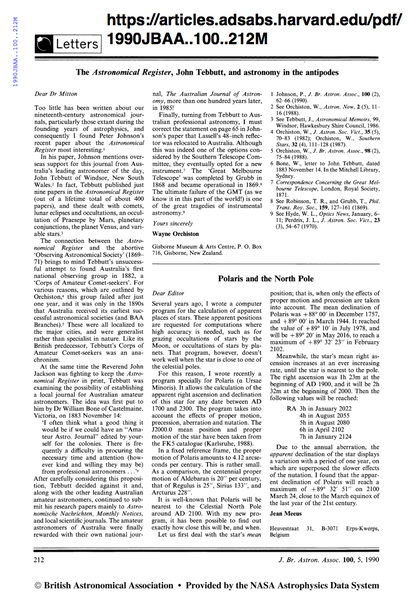
**Polaris and Guidestones Debunked** The Angular Displacement of Polaris.
While it is true one 'could have' seen Polaris through a hole in the now demolished guidestones, but the hole had to have been big enough to all for its star trail mini circular "orbit" around true Celestial North. I hope you realize Polaris is provably .66 degree off from being the true North Star.
And Polaris is PROVABLY moving but very slowly. It turns out Polaris is moving closer to its closest point year by year (2100 it will be .45 degrees from center which will be its closest - it will never be true North) making the Georgia Guidestone hole perfectly explainable even with this slow motion. That is, even if Ted turner or whoever erected that 40 years ago or whatever, the hole would have had to be big enough for the LARGER mini star trail of Polaris then, than it is now. Meaning Polaris is moving CLOSER to the bullseye not farther.
Now this is a subtle point so I don't hold it against people like yourself and David Weiss for not getting it right, but it is the measurable truth of the slow path of Polaris around the earth's 25,722 year precession cycle.
Snippet below from:
Meeus, J. (1990). "Polaris and the North Pole". Journal of the British Astronomical Association. 100: 212. Bibcode:1990JBAA..100..212M
https://articles.adsabs.harvard.edu/pdf/1990JBAA..100..212M
While it is true one 'could have' seen Polaris through a hole in the now demolished guidestones, but the hole had to have been big enough to all for its star trail mini circular "orbit" around true Celestial North. I hope you realize Polaris is provably .66 degree off from being the true North Star.
And Polaris is PROVABLY moving but very slowly. It turns out Polaris is moving closer to its closest point year by year (2100 it will be .45 degrees from center which will be its closest - it will never be true North) making the Georgia Guidestone hole perfectly explainable even with this slow motion. That is, even if Ted turner or whoever erected that 40 years ago or whatever, the hole would have had to be big enough for the LARGER mini star trail of Polaris then, than it is now. Meaning Polaris is moving CLOSER to the bullseye not farther.
Now this is a subtle point so I don't hold it against people like yourself and David Weiss for not getting it right, but it is the measurable truth of the slow path of Polaris around the earth's 25,722 year precession cycle.
Snippet below from:
Meeus, J. (1990). "Polaris and the North Pole". Journal of the British Astronomical Association. 100: 212. Bibcode:1990JBAA..100..212M
https://articles.adsabs.harvard.edu/pdf/1990JBAA..100..212M
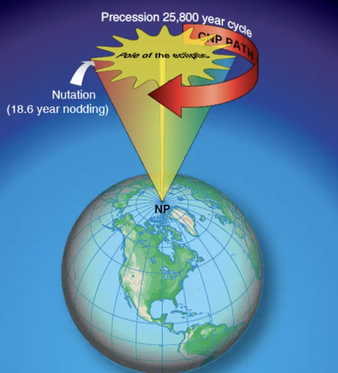
2016: If you convert 80 degrees 20 minutes to decimal you 89.33, substract from 90 =
.67 degrees
2100: If you convert 89 degrees 32 minutes 51 seconds to decimal 89.55 degrees, substract from 90 =
.45 degrees in 2100.
His calculations accounted for:
1) Precession,
2) Proper motion,
3) Aberration ( caused by the motion of the Solar System in space)
4) Nutation. Shown below
.67 degrees
2100: If you convert 89 degrees 32 minutes 51 seconds to decimal 89.55 degrees, substract from 90 =
.45 degrees in 2100.
His calculations accounted for:
1) Precession,
2) Proper motion,
3) Aberration ( caused by the motion of the Solar System in space)
4) Nutation. Shown below
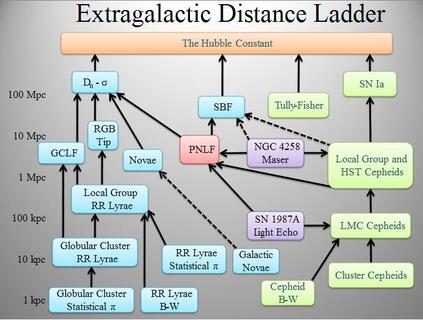
Measuring Cosmological Distances
https://en.wikipedia.org/wiki/Cosmic_distance_ladder
Parallax
Standard Candles
Standard Sirens
Standard Rulers
https://en.wikipedia.org/wiki/Cosmic_distance_ladder
Parallax
Standard Candles
Standard Sirens
Standard Rulers
Why we CAN see Alpha Centauri and over 6000 distant stars with the naked eye!
I heard a flat earth influencer in a recent interview talked about how there is no way that we should see Alpha Centauri our nearest star that is 4.4 light years away. His hand waving arguments invoke the inverse square law and blowing up a balloon with the rubber spreading thinner and thinner as you blow it up. He was trying to explain how the light spreads out which is not totally wrong as a metaphor, but he did not do the actual math to prove his point. Just saying that there is no way we should see it and that is too unbelievable is not an argument or a proof of ANY KIND!
Let's see why he is wrong and why WE CAN EASILY SEE ALPHA Centauri.
**Step One: Calculate The Luminosity of the Star**
Alpha Centauri is 10% more massive than the sun and 1.59 times the luminosity (power).
This comes out to 5.813 x 10^26 Watts (a lot of power)!
**Step two: Calculate the Brightness**
Brightness falls as an inverse square as David correctly says in his talks. Luminosity is constant , where brightness falls off by distance squared and related by the formula
B= L/(4*pi*x^2)
B is the brightness (Watts / meter^2 - what we see), L is the luminosity (power emitted by the star) and and x is the distance away in meters..
You can calculate B based on the inverse square relation above (just plug into equation above) and you get a Brightness coming from Alpha Centauri of ...drumroll please
B = 2.7 x 10^-8 Watts/Meter^2
**Step 3: Q: Can we see it?***
Ok that does not seem like a lot of brightness but the known minimum intensity of light detected by the human eye is 10^-10 Watts/Meter^2.
**Step 4: ANS - YES WE CAN!**
So the brightness of Alpha Centauri is 27 times or 2700% above the minimum threshold which we can EASILY see (and it is one of the brightest stars in the sky.
In terms of photons:
Minimum photons the eye can see at peak of visible light would be 300 per second. Eyes are small...
Equated to photons in the peak visible light range , this would be about 8100 photons per second and yes coming from Alpha Centauri!!
About 8000 photons per second FROM ALPHA CENTAURI hit your eyes when you look at Alpha Centauri on a clear night!! It took those photons 4.4 light years but they came from Alpha Centauri!
Isn't that amazing! Real science is so much more interesting than Fairy Tale Flat Earth Science
I heard a flat earth influencer in a recent interview talked about how there is no way that we should see Alpha Centauri our nearest star that is 4.4 light years away. His hand waving arguments invoke the inverse square law and blowing up a balloon with the rubber spreading thinner and thinner as you blow it up. He was trying to explain how the light spreads out which is not totally wrong as a metaphor, but he did not do the actual math to prove his point. Just saying that there is no way we should see it and that is too unbelievable is not an argument or a proof of ANY KIND!
Let's see why he is wrong and why WE CAN EASILY SEE ALPHA Centauri.
**Step One: Calculate The Luminosity of the Star**
Alpha Centauri is 10% more massive than the sun and 1.59 times the luminosity (power).
This comes out to 5.813 x 10^26 Watts (a lot of power)!
**Step two: Calculate the Brightness**
Brightness falls as an inverse square as David correctly says in his talks. Luminosity is constant , where brightness falls off by distance squared and related by the formula
B= L/(4*pi*x^2)
B is the brightness (Watts / meter^2 - what we see), L is the luminosity (power emitted by the star) and and x is the distance away in meters..
You can calculate B based on the inverse square relation above (just plug into equation above) and you get a Brightness coming from Alpha Centauri of ...drumroll please
B = 2.7 x 10^-8 Watts/Meter^2
**Step 3: Q: Can we see it?***
Ok that does not seem like a lot of brightness but the known minimum intensity of light detected by the human eye is 10^-10 Watts/Meter^2.
**Step 4: ANS - YES WE CAN!**
So the brightness of Alpha Centauri is 27 times or 2700% above the minimum threshold which we can EASILY see (and it is one of the brightest stars in the sky.
In terms of photons:
Minimum photons the eye can see at peak of visible light would be 300 per second. Eyes are small...
Equated to photons in the peak visible light range , this would be about 8100 photons per second and yes coming from Alpha Centauri!!
About 8000 photons per second FROM ALPHA CENTAURI hit your eyes when you look at Alpha Centauri on a clear night!! It took those photons 4.4 light years but they came from Alpha Centauri!
Isn't that amazing! Real science is so much more interesting than Fairy Tale Flat Earth Science
=======
Something we can talk about.
Angular size of a candle 1.6 miles away.
The brightness of a light source can be defined as the intensity of light received at a point some distance away from the source. The observed brightness of a light source depends on two factors - the luminosity of the source, and the distance from the source to the point of observation.
The brightness observed is expressed in terms of watts per square meter and luminosity of a light source in watts.
Brightness affects distance.
Alpha Centauri is only about ten times more massive than earth.
The brightness observed at a distance x from a light source of luminosity L is
L= 1.59L(sun) = 5.813 x 10^26 watts.
B=L/(4*pi*x^2)
Apparent brightness of alpha Centauri is 2.7 x 10^-8 W/m2
The minimum intensity of light to be detected by human eye is 10−10W/m2.
The number of photons of wavelength green minimum.
5000 or 6000 photons per second.
Life of a photon is 10^18 years.
But I think the main takeaway here is that brightness is what diminishes, not the photons themselves. If even a couple photons per second from that point in the sky make it to your eye, then it's visible. The more photons, the more brightness. It will never be zero. Following that, the sheer volume of photons being emitted from a star must be on a scale of such immensity that I fail to conceive of a description.
====
Mass-Luminosity Relation - used for Main Sequence stars to estimate their luminosity.
Formula:L = M^3.5
Luminosity-Radius-Temperature - the formula that relates these three characteristics of a star. This formula is given in two ways, the general format (which we won't use) and the one where the values are given in terms of the Sun's values (we'll use this one).
Formula:L = R^2*T^4 where:
L = luminosity of the star given in terms of the Sun's luminosity
M = mass of the star given in terms of the Sun's mass
Something we can talk about.
Angular size of a candle 1.6 miles away.
The brightness of a light source can be defined as the intensity of light received at a point some distance away from the source. The observed brightness of a light source depends on two factors - the luminosity of the source, and the distance from the source to the point of observation.
The brightness observed is expressed in terms of watts per square meter and luminosity of a light source in watts.
Brightness affects distance.
Alpha Centauri is only about ten times more massive than earth.
The brightness observed at a distance x from a light source of luminosity L is
L= 1.59L(sun) = 5.813 x 10^26 watts.
B=L/(4*pi*x^2)
Apparent brightness of alpha Centauri is 2.7 x 10^-8 W/m2
The minimum intensity of light to be detected by human eye is 10−10W/m2.
The number of photons of wavelength green minimum.
5000 or 6000 photons per second.
Life of a photon is 10^18 years.
But I think the main takeaway here is that brightness is what diminishes, not the photons themselves. If even a couple photons per second from that point in the sky make it to your eye, then it's visible. The more photons, the more brightness. It will never be zero. Following that, the sheer volume of photons being emitted from a star must be on a scale of such immensity that I fail to conceive of a description.
====
Mass-Luminosity Relation - used for Main Sequence stars to estimate their luminosity.
Formula:L = M^3.5
Luminosity-Radius-Temperature - the formula that relates these three characteristics of a star. This formula is given in two ways, the general format (which we won't use) and the one where the values are given in terms of the Sun's values (we'll use this one).
Formula:L = R^2*T^4 where:
L = luminosity of the star given in terms of the Sun's luminosity
M = mass of the star given in terms of the Sun's mass
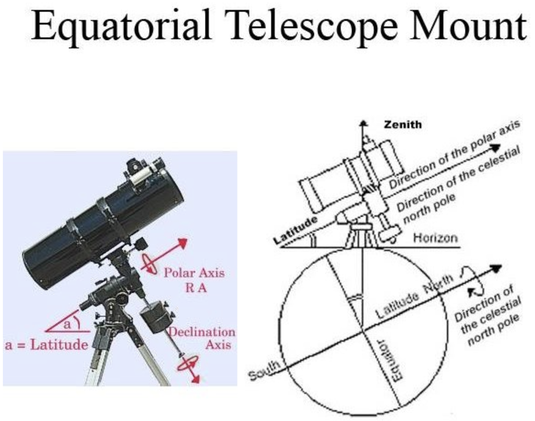
**Equatorial Telescope Mounts Debunk Flat Earth**
An equatorial mount is a telescope mount, where one axis is aligned parallel to the axis of rotation of earth (towards one of the celestial poles). Therefore a single axis movement can cancel out earth’s rotation to keep it pointed at any celestial object for a longer time. This is well proven to work. A flat earth with stars rotation concentric about the northern celestial pole would require always correction around two axes to track a star. The polar axis of an equatorial mount would always be not aligned with the celestial rotation of a flat earth.
Therefore the fact, that an equatorial mount works perfectly, is in no way compatible with a flat earth. To maintain the notion, that earth is flat, one would have to deny the fact, that equatorial mounts work - which would be really hard to do, as thousands of people own telescopes with equatorial mounts - and they know, that they work.
An equatorial mount is a telescope mount, where one axis is aligned parallel to the axis of rotation of earth (towards one of the celestial poles). Therefore a single axis movement can cancel out earth’s rotation to keep it pointed at any celestial object for a longer time. This is well proven to work. A flat earth with stars rotation concentric about the northern celestial pole would require always correction around two axes to track a star. The polar axis of an equatorial mount would always be not aligned with the celestial rotation of a flat earth.
Therefore the fact, that an equatorial mount works perfectly, is in no way compatible with a flat earth. To maintain the notion, that earth is flat, one would have to deny the fact, that equatorial mounts work - which would be really hard to do, as thousands of people own telescopes with equatorial mounts - and they know, that they work.
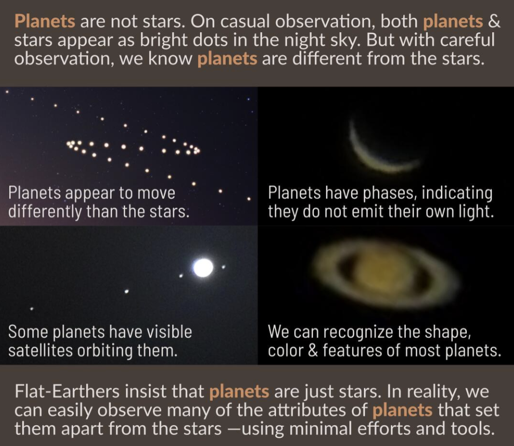
Planets - Show me the Orbits!
**The earth is not stationary & (and it sure isn't flat)!**
Flat-Earthers claim that Earth is stationary. In reality, from observing the planets’ motion, the most plausible explanation is that all planets, including Earth, are in motion around the Sun.
Planets appear to move near the ecliptic —the line that marks the annual path of the Sun against background stars. From these motions, it is obvious that Venus and Mercury are in motion around the Sun. And the motion of the other planets can only be explained if Earth is in motion around the Sun. Otherwise you end up with the ole' epicycle problem of the Ptolemaic geocentric model. A problem that the heliocentric model corrected and simplified , but sadly a problem the flat earth model makes even worse because at least the Geocentric model had the earth as a sphere!
Ancient Greeks called these lights planētes asteres, "wandering stars" or simply planētai, "wanderers"), from which today's word "planet" was derived.
This is mars photographed once a week over a period of months. Rather than traveling in a straight line across the background of the stars, it occasionally changes direction and loops back on itself. It is very hard to explain these retrograde loops if the earth is at the center of the universe.
Took over 2000 years to work this retrograde motion, key is understanding the Sun is at the center of the solar system, not the earth.
**The earth is not stationary & (and it sure isn't flat)!**
Flat-Earthers claim that Earth is stationary. In reality, from observing the planets’ motion, the most plausible explanation is that all planets, including Earth, are in motion around the Sun.
Planets appear to move near the ecliptic —the line that marks the annual path of the Sun against background stars. From these motions, it is obvious that Venus and Mercury are in motion around the Sun. And the motion of the other planets can only be explained if Earth is in motion around the Sun. Otherwise you end up with the ole' epicycle problem of the Ptolemaic geocentric model. A problem that the heliocentric model corrected and simplified , but sadly a problem the flat earth model makes even worse because at least the Geocentric model had the earth as a sphere!
Ancient Greeks called these lights planētes asteres, "wandering stars" or simply planētai, "wanderers"), from which today's word "planet" was derived.
This is mars photographed once a week over a period of months. Rather than traveling in a straight line across the background of the stars, it occasionally changes direction and loops back on itself. It is very hard to explain these retrograde loops if the earth is at the center of the universe.
Took over 2000 years to work this retrograde motion, key is understanding the Sun is at the center of the solar system, not the earth.
Bokeh
**Nikon P900 and Bokeh**!
Why am I still seeing flat earthers' share clearly out of focus Bokeh images of planets like Venus when it has been pointed out to them MANY TIMES these types of images are provably out of focus shots! It is so ridiculous you can get a tea candle to look like Venus? I know it looks cool, but it is just an out of focus shot!
That’s why their pictures are so different from the actual Venus (and other planets) we know. They obviously used autofocus, and the P900 struggled to autofocus on tiny objects on pitch black background, like Venus. Photography is not exactly flat-Earthers’ strong point, and it shows.
If Venus is in crescent phase, then why is it round when out of focus? The round figure is what we call ‘bokeh’. It is round because the shape of the aperture of the lens is also round. Some lenses have an aperture that is not perfectly round (especially when stopped down), and it will be apparent on the out of focus part of the image.
In Venus videos taken by the P900, why are there rippling effects on out of focus image of Venus? The rippling effects are caused by random atmospheric distortions.
But can we take a focused picture of Venus using the P900? Absolutely. We can workaround this shortcoming by switching off autofocus and use manual focus. See image on the bottom left which we can get from manual focus and see the Venus image we are familiar with!
**NOTE: In photography, bokeh is the way a lens renders out-of-focus points of light. The shape of bokeh depends on the shape of the lens’s aperture more than the out-of-focus objects themselves.
**Nikon P900 and Bokeh**!
Why am I still seeing flat earthers' share clearly out of focus Bokeh images of planets like Venus when it has been pointed out to them MANY TIMES these types of images are provably out of focus shots! It is so ridiculous you can get a tea candle to look like Venus? I know it looks cool, but it is just an out of focus shot!
That’s why their pictures are so different from the actual Venus (and other planets) we know. They obviously used autofocus, and the P900 struggled to autofocus on tiny objects on pitch black background, like Venus. Photography is not exactly flat-Earthers’ strong point, and it shows.
If Venus is in crescent phase, then why is it round when out of focus? The round figure is what we call ‘bokeh’. It is round because the shape of the aperture of the lens is also round. Some lenses have an aperture that is not perfectly round (especially when stopped down), and it will be apparent on the out of focus part of the image.
In Venus videos taken by the P900, why are there rippling effects on out of focus image of Venus? The rippling effects are caused by random atmospheric distortions.
But can we take a focused picture of Venus using the P900? Absolutely. We can workaround this shortcoming by switching off autofocus and use manual focus. See image on the bottom left which we can get from manual focus and see the Venus image we are familiar with!
**NOTE: In photography, bokeh is the way a lens renders out-of-focus points of light. The shape of bokeh depends on the shape of the lens’s aperture more than the out-of-focus objects themselves.

